Grand Rapids, Michigan, Hgh State Clinic, Hgh Injections, Hrt Doctors
Grand Rapids, Michigan Blood Testing Facilities
 Represents a LabCorp blood testing facility
Represents a LabCorp blood testing facility Represents a Quest Diagnostics blood testing facility
Represents a Quest Diagnostics blood testing facility
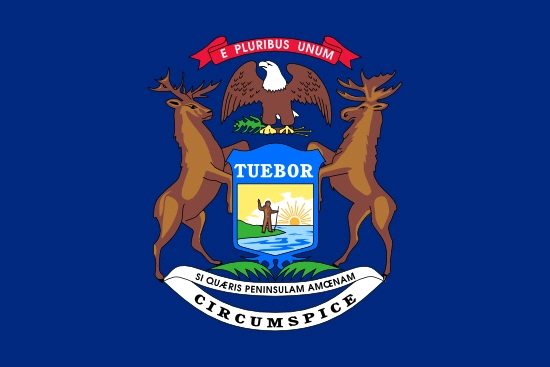
Nearby Labcorp Blood Testing facilities:
- Labcorp Center Distance: 5 m, 1155 E Paris Se Suite 200, Grand Rapids, Kent County, MI, 49546
- Labcorp Center Distance: 91 m, 3515 N Main St. Ste 2, Mishawaka, St Joseph County, IN, 46545
- Labcorp Center Distance: 95 m, 3250 Intertech Dr Ste C, Angola, Steuben County, IN, 46703
Nearby Quest Blood Testing facilities:
- Quest Center Distance: 0 m, 515 Michigan St Ne, Grand Rapids, Kent County, MI, 49503-5721
- Quest Center Distance: 4 m, 3935 Lake Michigan Dr Nw, Grand Rapids, Kent County, MI, 49534-7844
- Quest Center Distance: 7 m, 4763 Wilson Ave Sw, Grandville, Kent County, MI, 49418-9015
- Quest Center Distance: 33 m, 433 Seminole Rd, Muskegon, Muskegon County, MI, 49444-3743
- Quest Center Distance: 45 m, 5555 Gull Rd, Kalamazoo, Kalamazoo County, MI, 49048-7640
- Quest Center Distance: 63 m, 520 N. Mission, Mt. Pleasant, Isabella County, MI, 48858-5003
- Quest Center Distance: 74 m, 2500 Niles Rd, Saint Joseph, Berrien County, MI, 49085-3272
- Quest Center Distance: 81 m, 300 W Washington Ave, Jackson, Jackson County, MI, 49201-2180
- Quest Center Distance: 86 m, 555 W Wackerly St, Midland, Midland County, MI, 48640-4713
- Quest Center Distance: 89 m, 520 Cobb St, Cadillac, Wexford County, MI, 49601-2588
- Quest Center Distance: 90 m, 16597 State Road 23, South Bend, St Joseph County, IN, 46635-1461
- Quest Center Distance: 92 m, 4705 Towne Centre Rd, Saginaw, Saginaw County, MI, 48604-2818
- Quest Center Distance: 94 m, 6185 Dixie Hwy, Bridgeport, Saginaw County, MI, 48722-9618
- Quest Center Distance: 95 m, 1397 S Linden Rd, Flint, Genesee County, MI, 48532-4194
- Quest Center Distance: 97 m, G1071 N Ballenger Hwy, Flint, Genesee County, MI, 48504-4453
- Quest Center Distance: 98 m, 200 S Wenona St, Bay City, Bay County, MI, 48706-8820
- Quest Center Distance: 99 m, 425 N Fenway Dr, Fenton, Genesee County, MI, 48430-3810
Grand Rapids Michigan Hormone Replacement Therapy Services
Hormone Optimization is one of the most talked about forms of Wellness Medicine in America today. Decades of scientific and clinical research have provided powerful evidence regarding the importance of Hormone Balance and how our Hormones sustain and keep us happy and healthy when they are produced as is intended.
The risk of health issues increases dramatically when Hormone Levels fall into a state of imbalance, and the Conscious Evolution Institute specializes in preserving health and wellness through the use of Physician-Mediated Hormone Therapy with HGH, Testosterone, and other important Hormones. Our clinic is licensed and board-certified to diagnose and treat Hormone Disorders which inhibit health, including Testosterone Deficiency and Hypopituitarism, also known as HGH Deficiency.
If you are 30 years or older, and feel that Hormone Imbalance is an impediment to your health and your lifestyle, our clinic can arrange for prompt diagnosis and care, so that you can get the HRT Treatment that you need and deserve, promptly and at a competitive cost.
Our Hormone Clinic has strong relationships with doctors all throughout the Grand Rapids-Muskegon-Holland area, and we can arrange for an appointment with a medical professional that can aid us in our quest to serve you by providing us with a blood sample and physical which gives us the medical data that we need to learn the underlying causes of your current health issues. If you are interested in Affordable and Legal Testosterone and Growth Hormone from a reputable Hormone Clinic, contact the Conscious Evolution Institute today!
Grand Rapids Michigan Human Growth Hormone Injections for Diagnosed HGH Deficiency
One of the most devastating forms of Hormone Imbalance is Age-Related Human Growth Hormone Deficiency, which is also known as Somatopause. HGH is responsible for maintaining normal and healthy cellular metabolism, and is essential for the routine maintainance and upkeep of the human body.
When HGH Levels get too low, it leads to a wide variety of symptoms which seriously impede human wellness, including slow healing, depression, weight gain, reduced strength, inhibited energy levels, memory issues, increased severity and susceptibility to illness and more. With daily HGH Injections, it is possible to slow down or even reverse many of the symptoms of Growth Hormone Deficiency. HGH Brands include Nutropin, Humatrope, and Omnitrope.
Recombinant Human Growth Hormone Injections are nearly painless, and can provide significant and life-changing results in a matter of months, especially when combined with lifestyle changes, diet, and exercise.
Grand Rapids Michigan Sermorelin Acetate Therapy for Growth Hormone Optimization
Another medical option on the table for patients with HGH Imbalance is Sermorelin Therapy. The Conscious Evolution Institute provides Sermorelin as a quality Growth Hormone Alternative which has been clinically shown to effectively treat Growth Hormone Deficiency for most patients with Age-Associated Hypopituitarism. Sermorelin is notable for being less expensive than Real HGH while also providing similar results to most patients. If you would like to know more, our HGH Doctors and HRT Specialists are standing by to take your call!
Grand Rapids Michigan Bio-Identical Testosterone Replacement for Low-T
Along with HGH Deficiency Treatment, our Hormone Clinic prides itself on our Quality Testosterone Treatments and Low-T Prescriptions. Every year that a man ages past thirty, he becomes more susceptible to physiological complications stemming from Testosterone Deficiency. Countless males across both the state of Michigan and the entire United States suffer as a result of abnormally low Testosterone Levels. Millions of American men have successfully sought out treatment, but millions more go undiagnosed and untreated, even today.
For men with Hypogonadism, Testosterone Creams, Patches, and Injections have been shown to improve sexual health and vitality, enhance energy and muscle mass, reduce body fat, and improve mood and overall quality of life. Testosterone has even been shown to improve cardiovascular health and reduce the risk of certain potentially life-threatening conditions when used under the guidance of a qualified Prescribing Hormone Physician.
Grand Rapids Michigan Information
The city of Grand Rapids is located in west-central Michigan, and is the second most populous city in the state, behind only Detroit. The city is situated on the Grand River, which flows from Jackson to Grand Haven. Grand Rapids is located in Kent County. The highest building in Grand Rapids is the River House Condominiums, and other buildings which mark the Grand Rapids Skyline are the JW Marriot and the Grand Plaza Hotel.
Grand Rapids goes by a few different comment nicknames. It is referred to as the Furniture City because it has historically been the production center for some of the largest furniture companies in the world, and still retains much of that business today. Grand Rapids is also referred to as Beer City USA because of the proliferation of quality craft breweries in the city, including Grand Rapids Brewing Company, Founders Brewing, and Brewery Vivant. The city has long gone by the name The River City for obvious reasons.
Grand Rapids Education
Grand Rapids is notable for having a number of universities and colleges that meet and exceed the needs of Michigan Residents. Kuyper College, Grace Bible College, Cornerstone University, Calvin College, and Aquinas College are all based in Grand Rapids. The largest center for higher education in the region is Grand Valley State University, which is situated just outside the city in Allendale Michigan.
Grand Rapids Suburbs and Neighborhoods
Suburbs of Grand Rapids include Kentwood, Wyoming, Walker, Comstock Park, Forest Hills ,Cascade, and Lamont. Among the neighborhoods in Grand Rapids are Creston, Auburn Hills, Cherry Run, Westside Connection, Baxter, Michigan Oaks, Breton Village, South East End, Garfield Park, Midtown, and East Hills.
Grand Rapids Jobs and Points of Interest
Grand Rapids has a strong economy which has significantly diversified since the mid-20th century. Major employers in Grand Rapids include Fifth Third Bank, Steelcase, SpartanNash, Johnson Controls, Meijer, Axios Inc., and Spectrum Health.
There are many places of interest which draw people to the city of Grand Rapids, including the Gerald R. Ford Museum, John Ball Zoological Gardens, the Forest Hills Fine Arts Center, Can Andel Arena, and the Orbit Room.
All About Grand Rapids, Michigan Geographic Area
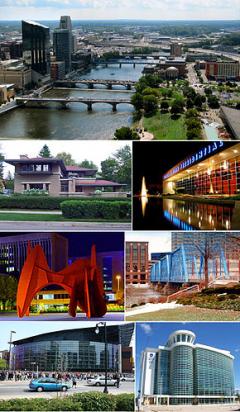


Grand Rapids is a city in the U.S. state of Michigan. The city is located on the Grand River about 25 miles east of Lake Michigan. As of the 2010 census, the city population was 188,040. In 2010, the Grand Rapids metropolitan area had a population of 774,160 and a combined statistical area, Grand Rapids-Muskegon-Holland, population of 1,321,557. It is the county seat of Kent County, Michigan, second largest city in Michigan (after Detroit), and the largest city in West Michigan. Grand Rapids is home to five of the world's leading office furniture companies and is nicknamed the "Furniture City". The city and surrounding communities are economically diverse, and contribute heavily to the health care, information technology, automotive, aviation, and consumer goods manufacturing industries, among others.
Grand Rapids was the hometown of Gerald Ford, the 38th President of the United States. He, along with his wife, former First Lady Betty Ford, are buried on the grounds of the Gerald R. Ford Presidential Museum in Grand Rapids.
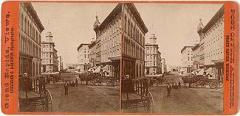
Over 2,000 years ago, people associated with the Hopewell culture occupied the Grand River Valley. Around A.D. 1700, the Ottawa Indians moved into the area and founded several villages along the Grand River.
The Grand Rapids area was first settled by Europeans near the start of the 19th century by missionaries and fur traders. They generally lived in reasonable peace alongside the Ottawa tribespeople, with whom they traded their European metal and textile goods for fur pelts. Joseph and Madeline La Framboise established the first Indian/European trading post in West Michigan, and in present Grand Rapids, on the banks of the Grand River near what is now Ada. After the death of her husband in 1806, Madeline La Framboise carried on, expanding fur trading posts to the west and north. La Framboise, whose ancestry was a mix of French and Indian, later merged her successful operations with the American Fur Company. She retired, at age 41, to Mackinac Island. The first permanent white settler in the Grand Rapids area was a Baptist minister named Isaac McCoy who arrived in 1825.
In 1826 Detroit-born Louis Campau, the official founder of Grand Rapids, built his cabin, trading post, and blacksmith shop on the east bank of the Grand River near the rapids. Campau returned to Detroit, then came back a year later with his wife and $5,000 of trade goods to trade with the native tribes. In 1831 the federal survey of the Northwest Territory reached the Grand River and set the boundaries for Kent County, named after prominent New York jurist James Kent. Campau became perhaps the most important settler when, in 1831, he bought 72 acres (291,000 m ²) of what is now the entire downtown business district of Grand Rapids. He purchased it from the federal government for $90 and named his tract Grand Rapids. Rival Lucius Lyon, who purchased the rest of the prime land, called his the Village of Kent. Yankee immigrants (primarily New Englanders of English colonial descent) and others began immigrating from New York and New England in the 1830s.
In 1836 John Ball, representing a group of New York land speculators, bypassed Detroit for a better deal in Grand Rapids. Ball declared the Grand River valley "the promised land, or at least the most promising one for my operations."
By 1838, the settlement incorporated itself as a village, and encompassed an area of approximately three-quarters of a mile (1 km) . The first formal census occurred in 1845, which announced a population of 1,510 and recorded an area of four square miles. The city of Grand Rapids was incorporated April 2, 1850 and officially created on May 1, 1850, when the village of Grand Rapids voted to accept the proposed city charter. The population at the time was 2,686. By 1857, the city of Grand Rapids' boundary totaled 10.5 square miles (27 km2).
In 1880, the country's first hydro-electric generator was put to use on the city's west side.
Grand Rapids was an early participant in the automobile industry, serving as home to the Austin Automobile Company from 1901 until 1921.
In 1945, Grand Rapids became the first city in the United States to add fluoride to its drinking water.
Downtown Grand Rapids used to host four department stores: Herpolsheimer's (Lazarus in 1987), Jacobson's, Steketee's (founded in 1862), and Wurzburg's. Like most downtown regional department stores, they suffered the same fate of falling sales, caused largely by the flight to the suburbs, and consolidation in the 1980s and 1990s.

An outcropping of gypsum, where Plaster Creek enters the Grand River, was known to the native American inhabitants of the area, and was commented on by the pioneer geologist Douglass Houghton in 1838. This outcrop was first mined in 1841, at first in open cast mines, but later underground mines as well. Gypsum was ground locally for use as a soil amendment known as "land plaster". The Alabastine Mine in nearby Wyoming, Michigan was originally dug in 1907 to provide gypsum for the manufacture of stucco and wall coverings, notably the alabastine, favored by Arts and Crafts Movement architects. This mine has been converted to use as a storage facility.
During the second half of the 19th century, the city became a major lumbering center and the premier furniture manufacturing city of the United States. For this reason it was nicknamed "Furniture City". After an international exhibition in Philadelphia in 1876, Grand Rapids became recognized worldwide as a leader in the production of fine furniture. Furniture companies included the Widdicomb Furniture Company. National home furnishing markets were held in Grand Rapids for about 75 years, concluding in the 1960s. Today, Grand Rapids is considered a world leader in the production of office furniture.
The first improved road into the city was completed in 1855. This road was a private, toll plank road from Kalamazoo through Wayland, and was a primary route for freight and passengers until about 1868. This road connected to the outside world via the Michigan Central Railroad at Kalamazoo.
The first railroad into the city was the Detroit and Milwaukee Railroad, which commenced service in 1858. In 1869 the Lake Shore and Michigan Southern Railway connected to the city. The Grand Rapids and Indiana Railroad began passenger and freight service to Cedar Springs, Michigan on December 25, 1867 and to Fort Wayne, Indiana in 1870. This railroad expanded service to Muskegon in 1886. The Grand Rapids, Newaygo and Lake Shore Railroad completed a line to White Cloud in 1875. In 1888 the Detroit, Lansing and Northern Railroad connected with Grand Rapids.
Grand Rapids was a home to one of the first regularly scheduled passenger airlines in the United States when Stout Air Services began flights from Grand Rapids to Detroit (actually Ford Airport in Dearborn, Michigan) on July 31, 1926.
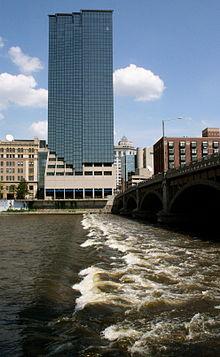
Grand Rapids sits on the banks of the Grand River, where there was once a set of rapids, at an altitude of 610 feet (186 m) above sea level. It is approximately 25 miles (40 km) east of Lake Michigan. The state capital of Lansing lies about 60 miles (100 km) to the east-by-southeast, and Kalamazoo is about 50 miles (80 km) to the south.
Grand Rapids is divided into four quadrants which form a part of mailing addresses in Kent County. The quadrants are NE (northeast), NW (northwest), SE (southeast), and SW (southwest). Fulton Street serves as the north-south dividing line, while Division Avenue serves as the east-west dividing line separating these quadrants.
According to the United States Census Bureau, the city has a total area of 45.3 square miles (117 km2), of which 44.6 square miles (116 km2) is land and 0.7 square mile (1.8 km ², 1.50%) is water (primarily the Grand River).
Grand Rapids has a humid continental climate (Koppen Dfb), with very warm and humid summers, cold and snowy winters, and short and mild springs and autumns. Owing to lake effect snow from Lake Michigan, the city averages 64 in (160 cm) of snow a year. The area often receives quick and sudden lake effect snowstorms, producing significant amounts of snowfall. Summers are warm or hot and the occurrence of heat waves and severe weather outbreaks is not uncommon during a typical summer.
The highest temperature in the area was recorded on July 13, 1936 at 108 °F (42 °C), and the lowest was recorded on February 14, 1899 at na24 °F ( na31 °C). During an average year, sunshine occurs in 46% of the daylight hours. On close to 40% of nights the temperature dips to below 32 °F (0 °C). On average, 11 days a year have temperatures that meet or exceed the 90 degree mark, and 9 days a year have temperatures that are 0 degrees or colder.
In April 1956, the western and northern portions of the city and its suburbs were hit by a violent tornado which locally produced F5 damage and killed 18.

The city skyline shows the Amway Grand Plaza Hotel which reopened in 1981 after extensive renovations done by Marvin DeWinter & Associates including the addition of a 29 story glass tower. The Pantlind was fashioned after English Adams architecture by designers Warren & Westmore and in its prime was rated as one of the top ten hotels in the US. The hotel is home to several well-known restaurants in Grand Rapids, such as Cygnus and the 1913 Room, which was Michigan's only AAA Five Diamond Award restaurant, before being replaced in May 2011 by Ruth's Chris Steakhouse.
The hotel is owned by Amway Hotel Collection, a subsidiary of Amway's holding company Alticor.
Other prominent large buildings include the JW Marriott Grand Rapids, the first JW Marriott Hotel in the Midwest. It is themed from the array of Grand Rapids Sister cities: Omihachiman, Japan; Bielsko-Biala, Poland; Perugia, Italy; Ga District, Ghana; and Zapopan, Mexico. When the hotel was first opened, Amway Hotel corporation hired photographer Dan Watts to travel to each of the sister cities and photograph them for the property. Each floor of the hotel features photography from one of the cities and is unique to that floor. The cities repeat themselves up the 23 floors.
The city's tallest building, which postdates the above photo, is the River House Condominiums. Completed in 2008, It is a 34 story (123.8 m) condominium tower and stands as the tallest all-residential building in the state of Michigan.
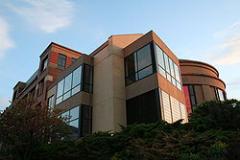
In 1969, Alexander Calder's abstract sculpture, La Grande Vitesse, which translates from French as "the great swiftness" or more loosely as "grand rapids," was installed downtown on the Vandenberg Plaza, the remodeled site of Grand Rapids City Hall. It became the first federally funded work of public art in the United States funded by the National Endowment for the Arts. Since then, the site has hosted an annual Festival of the Arts on the plaza, now known informally as "Calder Plaza." During the first weekend in June, several blocks of downtown surrounding the Calder stabile in Vandenberg Plaza are closed to traffic. Festival features several stages with free live performances, food booths selling a variety of ethnic cuisine, art demonstrations and sales, and other arts-related activities. Organizers bill it as the largest all-volunteer arts festival in the United States because it is organized and managed entirely by volunteers. Vandenberg Plaza also hosts various ethnic festivals that take place throughout the summer season.
Summer concludes with Celebration on the Grand the weekend after Labor Day featuring free concerts, fireworks display and food booths. Celebration on the Grand is an event that celebrates life in the Grand River valley. Each October, the city celebrates the Polish heritage centered on the West side of town with Pulaski Days.
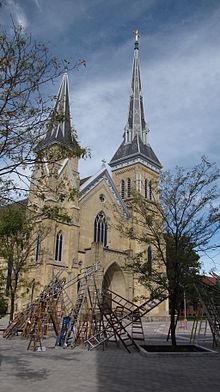
In Grand Rapids in 1973, the city hosted Sculpture off the Pedestal, an outdoor exhibition of public sculpture, which assembled 13 world-renowned artists, including Mark di Suvero, John Henry, Kenneth Snelson, Robert Morris, John Mason and Stephen Antonakos, in a single, citywide celebration. Sculpture off the Pedestal was a public/private partnership, which included financial support by the National Endowment for the Arts, educational support from the Michigan Council for the Arts and in-kind contributions from individuals, business and industry. Fund-raising events, volunteers and locals housing artists contributed to the public character of the event.
On November 10, 2004, the grand premier of the film The Polar Express was held in Grand Rapids, the movie's setting and home of the book's author Chris Van Allsburg, and its main character. The Meijer Gardens created a Polar Express display which was part of their larger Christmas Around the World exhibit.
In mid-2004, the Grand Rapids Art Museum (GRAM) began construction on a new, larger building for its art museum collection, which opened in October 2007 at 101 Monroe Center NW. The new building site faces downtown's Ecliptic by Maya Lin at Rosa Parks Circle. The Museum was completed in 2007 and became the first newly built art museum to achieve gold-level, LEED certification by the U.S. Green Building Council.
The first ArtPrize, the world's largest art competition completely voted on by the public, took place in Grand Rapids from September 23 through October 10, 2009. This event was founded by Rick DeVos, grandson of Amway Corp. co-founder Richard DeVos, who offered $449,000 in cash prizes. 1,262 artists exhibited their work for two weeks, with a total of 334,219 votes cast. First prize, including a $250,000 cash prize, went to Brooklyn painter Ran Ortner. The second event, ArtPrize 2010, was held September 22 through October 10, 2010 with work by 1,713 artists on display. The first prize was awarded to Grand Rapids artist Chris LaPorte.
In 2012, Grand Rapids tied with Asheville, North Carolina, for "Beer City USA". The competition was held by casting votes online for cities around the United States. Prominent breweries in the area such as B.O.B's Brewery, Brewery Vivant, Founders, Grand Rapids Brewing Co., Hideout, HopCat and Schmohz have created the culture necessary to win the award.
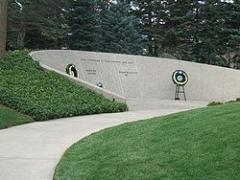
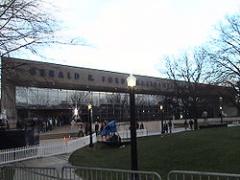
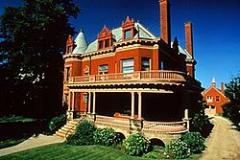
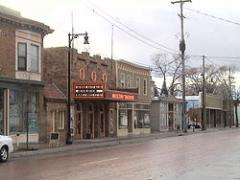
Grand Rapids is the home of John Ball Park, Belknap Hill, and the Gerald R. Ford Museum, the final resting place of the 38th President of the United States and former First Lady Betty Ford. Significant buildings in the downtown include the DeVos Place Convention Center, Van Andel Arena, the Amway Grand Plaza Hotel, and now the JW Marriott Hotel. The Urban Institute for Contemporary Arts is located downtown, and houses art exhibits, a movie theater, and the urban clay studio.
Along the Grand River are symbolic burial mounds which were used by the Hopewell tribe, a fish ladder, and a riverwalk.
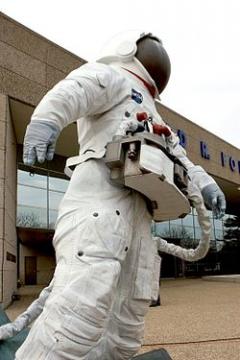
Grand Rapids is also home to the Van Andel Museum Center. Founded in 1854, it is among the oldest history museums in the United States. The museum's sites currently include the main site constructed in 1994 on the west bank of the Grand River (home to the Roger B. Chaffee Planetarium), the Voigt House Victorian Museum, and the City Archives and Records Center, which was the site of the museum and planetarium prior to 1994. The museum has, in the past few years, played host to a handful of notable exhibitions, including the Dead Sea Scrolls, and The Quest for Immortality: the Treasures of Ancient Egypt. The museum is set up as a non-profit institution owned and managed by the Public Museum of Grand Rapids Foundation.
Heritage Hill, a neighborhood directly east of downtown is one of the largest urban historic districts in the country. It was the first "neighborhood" of Grand Rapids and its 1,300 homes date from 1848 and represent over 60 architectural styles. Of particular significance is the Meyer May House, a prairie-style home designed by Frank Lloyd Wright in 1908. It was commissioned by local merchant Meyer May who operated a men's clothing store (May's of Michigan). The house is now owned and operated by Steelcase Corporation. Steelcase manufactured furniture for the Johnson Wax Building in Racine, WI, which was designed by Wright. Because of those ties, Steelcase purchased and restored the property in the 1980s. The restoration has been heralded as one of the most accurate and complete of any Wright restoration. The home is used by Steelcase for special events and open to the public for tours.
Grand Rapids is home to myriad theatres and stages, including the newly reconstructed Civic Theatre (also known as the Meijer Majestic), the city's largest theatre DeVos hall, and the convertible Van Andel Arena. Further east of downtown is the historic Wealthy Theatre. The first megaplex in the United States is also located in Grand Rapids, Studio 28, which reopened in 1988 with a seating capacity of 6,000. The theater ceased operations on November 23, 2008. The Grand Rapids company also owns many theaters around West Michigan.
In Grand Rapids Township, the Frederik Meijer Gardens and Sculpture Park combine 125 acres (1 km2) of world-class botanical gardens and artwork from such sculptors as Mark di Suvero, Alexander Calder, Edgar Degas, and Auguste Rodin. The Gardens' amphitheatre plays host to numerous concerts each summer, featuring such acts as Jonny Lang, The Pointer Sisters, Lyle Lovett, Cowboy Junkies, and B.B. King. The Gardens were mentioned in Patricia Schultz's book 1,000 Places to See Before You Die.
Grand Rapids has a number of popular concert venues in which a large assortment of bands have performed, including the Orbit Room, the Mixtape Cafe, the DAAC, the Intersection, DeVos Hall, the Van Andel Arena, the Royce Auditorium, the Forest Hills Fine Arts Center, and the Deltaplex.
The Schubert Male Chorus of Grand Rapids is considered the oldest independent continuing male chorus in America. Founded by Henry C. Post on November 19, 1883 they continue to perform today a variety of music.
The Grand Rapids Symphony, founded in 1930, presents more than 400 performances a year.
The Grand Rapids Barbershop Chapter Great Lakes Chorus is an all male a cappella barbershop harmony chorus including quartets and is one of the oldest chapters in the Barbershop Harmony Society (formally known as the Society for the Preservation and Encouragement of Barber Shop Quartet Singing in America or SPEBSQSA). The Grand Rapids chapter organized on November 1, 1939 for quartet singers and is credited for holding the first society sanctioned quartet contest in the "Michigan District" (now Pioneer District) in March 1941. And in 1944 the Grand Rapids Chapter is credited with having the first International Quartet champions, The Harmony Halls. In 1947 the Great Lakes Chorus (then called the Grand Rapids Chorus) was founded. In 1953 the first International Chorus Competition was held and the Great Lakes Chorus took First Place with the title first International Convention Championship Chorus under the direction of Robert Weaver. The chorus is still very active as a non-profit singing for community, competition, and contracted performances.
Grand Rapids Ballet Company was founded in 1971 and remains as Michigan's only professional ballet company. They are currently located on Ellsworth Avenue in the Heartside neighborhood, where it moved in 2000. In 2007, they expanded their facility by adding the LEED-certified Peter Wege Theater.
Opera Grand Rapids, founded in 1966, is the state's longest running professional company. In February 2010, they moved into a new facility in the Fulton Heights neighborhood.
A Newsweek article listing Grand Rapids as a "dying city" prompted a vigorous community response in the form of a 5,000-person lip dub in May 2011, which film critic Roger Ebert dubbed authe greatest music video ever made au. The lip dub holds the world record for largest lip dub.
Several professional sports teams call the Grand Rapids area home:
Each year the Fifth Third River Bank Run is held in downtown Grand Rapids. It draws participants from around the world; in 2010 there were over 22,000 participants. The Grand Rapids Marathon is held in downtown Grand Rapids in mid-October, usually on the same weekend as the Detroit Marathon.
Amateur sporting organizations in the area include the Grand Rapids Rowing Association, Grand Rapids Rugby Club, and the West Michigan Wheelchair Sports Association. The West Michigan Sports Commission is the host organizing committee for the inaugural State Games of Michigan, which will be held in Grand Rapids from June 25 to June 27, 2010.
The Grand Rapids Press is a daily newspaper, while Advance Newspapers publishes a group of weekly papers providing more community-based news. Gemini Publications is a niche, regional publishing company that produces the weekly newspaper Grand Rapids Business Journal, the magazines Grand Rapids Magazine, Grand Rapids Family and Michigan Blue, and several other quarterly and annual business-to-business publications. There are two free monthly entertainment guides: REVUE, which covers music and the arts, and RECOIL, which covers music and offers Onion-style satire. The Rapidian is an online-based citizen journalism project funded by grants from the Knight Foundation and local community foundations that is reprinted or cited by other local media outlets.
Grand Rapids, combined with nearby Kalamazoo and Battle Creek, was ranked in 2010 as the 41st largest television market in the U.S. by Nielsen Media Research. The market is served by stations affiliated with major American networks including: WOOD-TV (channel 8, NBC), WOTV (channel 41, ABC), WZZM-TV (channel 13, ABC), WXMI (channel 17, Fox), WXSP-CD (channel 15, MyNetworkTV) and Kalamazoo-based WWMT (channel 3, CBS). WGVU-TV is the area's PBS member station.
The Grand Rapids area is served by 16 AM radio stations and 28 FM stations.
Headquartered in Grand Rapids, Spectrum Health is the largest employer in West Michigan with 16,000 staff and 1,500 physicians. Spectrum Health's Meijer Heart Center, Lemmen-Holton Cancer Pavilion, and Butterworth Hospital, a level I trauma center are located on the Grand Rapids Medical Mile which has world-class facilities focusing on the health sciences. These facilities include the Van Andel Research Institute, Grand Valley State University's Cook-DeVos Center for Health Sciences, and the Michigan State University College of Human Medicine medical school's Secchia Center. Nearly a billion dollars has been invested in the Spectrum Health Cancer Pavilion, the Spectrum Health Helen DeVos Children's Hospital and the expansion to the Van Andel Institute. These facilities have attracted numerous health science businesses to the area.
Grand Rapids has long been a center for furniture, automobile, and aviation manufacturing; American Seating, Steelcase, Haworth and Herman Miller, major manufacturers of office furniture, are based in the Grand Rapids area. The area serves as an important location for GE Aviation Systems.
In 1880, Sligh Furniture Company started manufacturing furniture. In 1881, the Furniture Manufacturers Association (FMA) was organized in Grand Rapids, it was apparently the first furniture manufacturing advocacy group in the country. Also since 1912, Kindel Furniture Company, and since 1922, the Hekman/Woodmark Furniture Company, have been designing and manufacturing traditional American furniture in Grand Rapids. All of these companies are still producing furniture today.
The Grand Rapids area is home to a number of well known companies that include; Alticor/Amway (a consumer goods manufacturer and distributor), Bissell (a privately owned vacuum cleaner and floor care product manufacturer), Highlight Industries (an industry leader in stretch wrap equipment), Spartan Stores (a food distributor and grocery store chain), Foremost Insurance Company (a specialty lines insurance company), Meijer (a regional supercenter chain), GE Aviation (formerly Smiths Industries, an aerospace products company), Wolverine World Wide (a designer and manufacturer of shoes, boots and clothing), MC Sports, Inc. (a regional sports retail chain), Universal Forest Products (a building materials company), and Schuler Books & Music, one of the largest independent bookstores in the country.
The city is also known as a center of Christian publishing, home to Zondervan, Baker Books, Kregel Publications, and Eerdmans Publishing, as well as Family Christian Stores, a Christian bookstore chain.
The surrounding area is noted for its fruit production. Due to its close proximity to Lake Michigan the climate is considered prime for apple, peach, and blueberry farming.
In 2010 Grand Rapids was named the "most sustainable midsize city in the U.S." by the U.S. Chamber of Commerce Civic Leadership Center and Siemens Corp. Grand Rapids was chosen over finalist cities Davenport, Iowa and Hoover, Alabama.
As of the census of 2010, the population of Grand Rapids was 188,040, a decrease of 4.9% since 2000. The racial makeup of the city was 64.6% white, 20.9% African American, 1.9% Asian American, 0.7% Native American, 0.1% Pacific Islander American, and 4.2% from two or more races. 15.6% of the population was Hispanic or Latino, of any race. Foreign-born residents made up 10.7% of the population. Non-Hispanic Whites were 59% of the population in 2010, down from 86.9% in 1970.
The largest ancestry groups in Grand Rapids include: German, 23.4%; Dutch, 21.2%; English, 15.9%; Irish, 11.4%; Polish, 6.5%; French, 5.1%; Swedish, 2.7%; Scottish, 2.0%; and Scots-Irish, 1.3%.
Those citing "American" ancestry in Grand Rapids are of overwhelmingly English extraction, however most English Americans identify simply as having American ancestry because their roots have been in North America for so long, in many cases since the early sixteen hundreds.
As of the census of 2000, there were 197,800 people, 73,217 households, and 44,369 families residing in the city. The population density was 4,431.2 per square mile (1,710.8/km ²). There were 77,960 housing units at an average density of 1,746.5 per square mile (674.3/km ²). The racial makeup of the city was 67.30% White American (62.5% non-Hispanic White), 20.41% African American, 0.74% Native American, 1.62% Asian American, 0.12% Pacific Islander American, 6.63% from other races, and 3.19% from two or more races. 13.05% of the population were Hispanic or Latino of any race. The city had a foreign-born population of 10.5%.
There were 73,217 households out of which 32.0% had children under the age of 18 living with them, 40.3% were married couples living together, 15.8% had a female householder with no husband present, and 39.4% were non-families. 30.8% of all households were made up of individuals and 10.0% had someone living alone who was 65 years of age or older. The average household size was 2.57 and the average family size was 3.24.
In the city the population was spread out with 27.0% under the age of 18, 13.1% from 18 to 24, 31.5% from 25 to 44, 16.7% from 45 to 64, and 11.6% who were 65 years of age or older. The median age was 30 years. For every 100 females there were 95.8 males. For every 100 females age 18 and over, there were 92.5 males.
The median income for a household in the city was $37,224, and the median income for a family was $44,224. Males had a median income of $33,050 versus $26,382 for females. The per capita income for the city was $17,661. 15.7% of the population and 11.9% of families were below the poverty line. Out of the total people living in poverty, 19.4% are under the age of 18 and 10.4% are 65 or older.
The Christian Reformed Church has a large following in Grand Rapids, and its central offices are located near the city in the suburb of Kentwood.
Grand Rapids is home to the Roman Catholic Diocese of Grand Rapids, which was created on May 19, 1882 by Pope Leo XIII. The Diocese comprises 176,098 Catholics in West Michigan, 102 parishes, and four high schools: Catholic Central High School, Grand Rapids; Muskegon Catholic Central High School, Muskegon; St. Patrick High School, Portland; and West Catholic High School, Grand Rapids. Walter A. Hurley is the current Bishop of Grand Rapids.
Like the surrounding counties, the Grand Rapids area has traditionally been a stronghold for the Republican Party, but the city itself leans Democratic.
The city is the center of the 3rd Congressional District, represented by Republican Justin Amash. Former President Gerald Ford represented the district from 1949 to 1973. Ford died on December 26, 2006 at his home in Rancho Mirage, California, and was buried on the grounds of his Presidential Museum in Grand Rapids on January 3, 2007.
The Grand Rapids area (including the suburbs of Ada, East Grand Rapids, Wyoming, Grandville, Walker, and Kentwood) also serves as the home business base of one of the largest political donors to the national Republican Party, Richard and Helen DeVos, and also to the former Ambassador to Italy, Peter Secchia.
Though the Grand Rapids area has a reputation for conservatism, the city proper tends to elect Democrats. Both of its representatives in the Michigan State House of Representatives are Democrats, and in the five most recent presidential elections Democratic candidates Bill Clinton, Al Gore, John Kerry, and Barack Obama won a majority or plurality of votes in the city of Grand Rapids. The last Republican candidate for President to carry the city was George H.W. Bush in 1988.
Under Michigan law, Grand Rapids is a home rule city and adopted a city charter in 1916 providing for the Commission-Manager form of municipal government. Under this system, the political responsibilities are divided between an elected City Commission and a hired full-time City Manager. Two part-time Commissioners are elected to four-year terms from each of three wards, with half of these seats up for election every two years. The part-time Mayor is elected every four years by the city at large, and serves as chair of the Commission, with a vote equal to that of a Commissioner. The races aeheld in odd-numbered years aeare formally non-partisan, although the party and other political affiliations of candidates do sometimes come up during the campaign period. The Commission sets policy for the city, and is responsible for hiring the City Manager and other appointed officials.
George Heartwell was elected mayor of Grand Rapids after long-serving mayor John H. Logie declined to run for re-election in 2003. Logie felt the position should be made full-time, but to avoid the question becoming a referendum on whether he should hold the job full-time, he announced that he would not run for re-election. The voters decided to keep the position part-time, and Heartwell was elected and assumed office on January 1, 2004.
K ae12 public education is provided by the Grand Rapids Public Schools as well as a number of charter schools. Grand Rapids is home of the oldest co-educational Catholic high school in the United States, Catholic Central High School. National Heritage Academies, which operates charter schools across several states, has its headquarters in Grand Rapids.
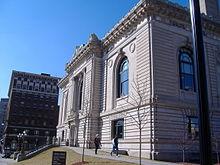
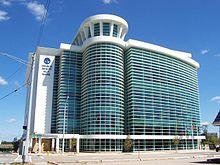
Grand Rapids is home to several colleges and universities. The private, religious schools Aquinas College, Calvin College, Cornerstone University, Grace Bible College, and Kuyper College each have a campus within the city. Thomas M. Cooley Law School, a private institution, also has a campus in Grand Rapids. Northwood University, a private university with its main campus in Midland, MI, has a satellite campus located downtown near the "medical mile". The for-profit vocational school ITT Technical Institute has one of its 105 campuses (located across 37 states of the US) located in Grand Rapids as well. Davenport University, a private, non-profit, multi-location university with 14 campuses state-wide, has its main campus just outside of Grand Rapids.
As for public tertiary institutions, Grand Rapids Community College (GRCC) maintains a campus downtown and facilities in other parts of the city and surrounding region. Grand Valley State University, with its main campus located in nearby Allendale, continues to develop its presence downtown by expanding its Pew campus, begun in the 1980s on the west bank of the Grand River. This downtown campus currently consists of 33 acres (13 ha) in two locations and is home to 11 buildings and three leased spaces. Ferris State University has a growing campus downtown, including the Applied Technology Center (operated with GRCC) and the Kendall College of Art and Design, a formerly private institution that now is part of Ferris. Western Michigan University has a long-standing graduate program in the city, with facilities downtown and in the southeast. The Van Andel Institute, a cancer research institute established in 1996, also resides on the medical mile; the institute established a graduate school in 2005 to train PhD students in cellular, genetic, and molecular biology.
Clinical Pastoral Education is also offered at Pine Rest Christian Mental Health Services in nearby Gaines Township, Michigan.
Grand Rapids is home to the Secchia Center medical education building, a $90 million, seven-story, 180,000-square-foot (17,000 m2) facility, at Michigan Street and Division Avenue, part of the Grand Rapids Medical Mile. The building is home to the Grand Rapids Campus of the Michigan State University College of Human Medicine. This campus trains medical students through all four years of their medical education. The state-of-the-art facility includes clinical examination rooms, simulation suites, classrooms, offices and student areas.
 I-96 runs along the northern and northeastern sides of the city, linking with Muskegon to the west and Lansing and Detroit, Michigan to the east
I-96 runs along the northern and northeastern sides of the city, linking with Muskegon to the west and Lansing and Detroit, Michigan to the east
Public bus transportation is provided by the Interurban Transit Partnership, which brands itself as The Rapid. Transportation is also provided by the DASH buses: the "Downtown Area Shuttle". These provide transportation to and from the parking lots in the city of Grand Rapids to various designated loading and unloading spots around the city. There are plans in the works to add more express routes, secondary stations, a streetcar and dedicated (exclusive) highway lanes. In the Summer of 2012, Megabus started service from Grand Rapids to Chicago, Detroit, East Lansing, Indianapolis, and Columbus.
Commercial air service to Grand Rapids is provided by Gerald R. Ford International Airport (GRR). Seven airlines operate over 150 daily flights to 23 nonstop destinations across the United States and to Toronto in Canada. The airport was previously named the Kent County International Airport.
The first regularly scheduled air service in the United States was between Grand Rapids and Detroit (actually Dearborn's Ford Airport) on a Ford-Stout monoplane named Miss Grand Rapids, which commenced July 26, 1926.
Amtrak provides direct train service to Chicago from the passenger station via the Pere Marquette line. Freight service is provided by CSX, the Grand Elk Railroad, Marquette Rail, the Coopersville and Marne Railway, and the Grand Rapids and Eastern Railroad.
Grand Rapids has city partnerships with the following cities:
Word Count: 6423






